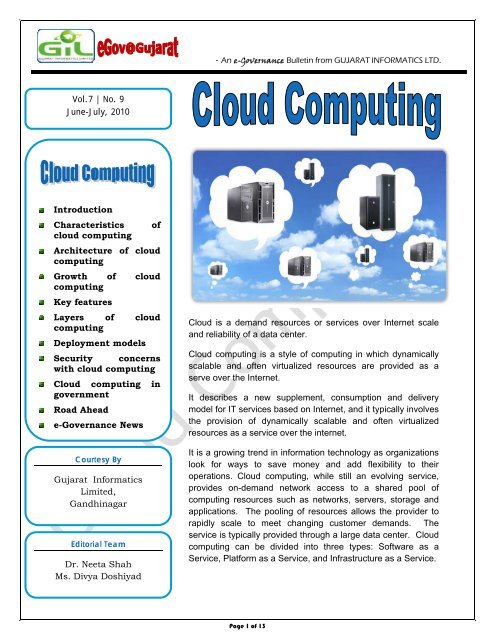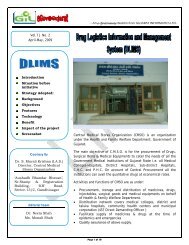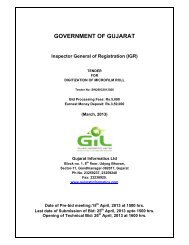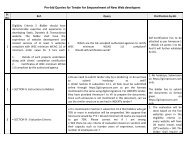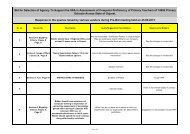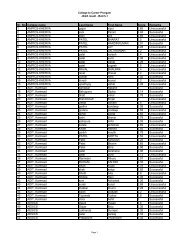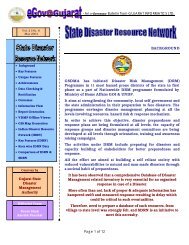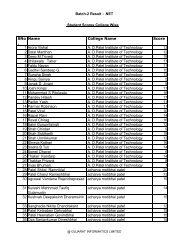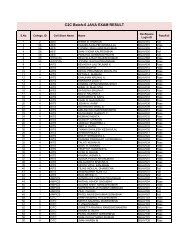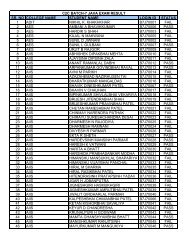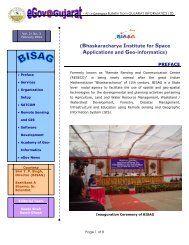Cloud Computing - Gujarat Informatics Limited
Cloud Computing - Gujarat Informatics Limited
Cloud Computing - Gujarat Informatics Limited
You also want an ePaper? Increase the reach of your titles
YUMPU automatically turns print PDFs into web optimized ePapers that Google loves.
- An e-Governance Bulletin from GUJARAT INFORMATICS LTD.Vol.7 | No. 9June-July, 2010IntroductionCharacteristicscloud computingofArchitecture of cloudcomputingGrowth of cloudcomputingKey featuresLayers of cloudcomputingDeployment modelsSecurity concernswith cloud computing<strong>Cloud</strong> computing ingovernmentRoad Aheade-Governance NewsCourtesy By<strong>Gujarat</strong> <strong>Informatics</strong><strong>Limited</strong>,GandhinagarEditorial TeamDr. Neeta ShahMs. Divya Doshiyad<strong>Cloud</strong> is a demand resources or services over Internet scaleand reliability of a data center.<strong>Cloud</strong> computing is a style of computing in which dynamicallyscalable and often virtualized resources are provided as aserve over the Internet.It describes a new supplement, consumption and deliverymodel for IT services based on Internet, and it typically involvesthe provision of dynamically scalable and often virtualizedresources as a service over the internet.It is a growing trend in information technology as organizationslook for ways to save money and add flexibility to theiroperations. <strong>Cloud</strong> computing, while still an evolving service,provides on-demand network access to a shared pool ofcomputing resources such as networks, servers, storage andapplications. The pooling of resources allows the provider torapidly scale to meet changing customer demands. Theservice is typically provided through a large data center. <strong>Cloud</strong>computing can be divided into three types: Software as aService, Platform as a Service, and Infrastructure as a Service.Page 1 of 13
- An e-Governance Bulletin from GUJARAT INFORMATICS LTD.Characteristic of cloud computing:• Virtual: Software, database, Web servers, operating systems, storage and networking as virtualservers.• Incremental Scalability: <strong>Cloud</strong> environments allow users to access additional compute resourceson-demand in response to increased application loads.• Agility: As a shared resource, the cloud provides flexible, automated management to distribute thecomputing resources among the cloud's users.• Reliability and Fault-Tolerance: <strong>Cloud</strong> environments take advantage of the built-in redundancy ofthe large numbers of servers that make them up by enabling high levels of availability and reliabilityfor applications that can take advantage of this.• Service-oriented: The cloud is a natural home for service-oriented applications, which need a wayto easily scale as services get incorporated into other applications.• Utility-based: Users only pay for the services they use, either by subscription or transaction-basedmodels.• Shared: By enabling IT resources to be consolidated, multiple users share a common infrastructure,allowing costs to be more effectively managed without sacrificing the security of each user's data.• SLA-driven: <strong>Cloud</strong>s are managed dynamically based on service-level agreements that definepolicies like delivery parameters, costs, and other factors.• APIs: Because clouds virtualize resources as a service they must have an application programminginterface (API).Architecture of cloud computing:<strong>Cloud</strong> architecture, the system architecture of thesoftware systems involved in the delivery of cloudcomputing, typically involves multiple cloudcomponents communicating with each other overapplication programming interfaces, usually webservices. This resembles the Unix philosophy ofhaving multiple programs each doing one thing welland working together over universal interfaces.Complexity is controlled and the resulting systemsare more manageable than their monolithiccounterparts.Page 2 of 13
- An e-Governance Bulletin from GUJARAT INFORMATICS LTD.<strong>Cloud</strong> computing logical diagram:Growth of cloud computing:<strong>Cloud</strong> computing comes into focus only when you think about what IT always needs: a way to increasecapacity or add capabilities on the fly without investing in new infrastructure, training new personnel, orlicensing new software. <strong>Cloud</strong> computing encompasses any subscription-based or pay-per-use service that,in real time over the Internet, extends its existing capabilities.<strong>Cloud</strong> computing is at an early stage, with a motley crew of providers large and small delivering a slew ofcloud-based services, from full-blown applications to storage services to spam filtering. Yes, utility-styleinfrastructure providers are part of the mix, but so are SaaS (software as a service) providers such asSalesforce.com. Today, for the most part, IT must plug into cloud-based services individually, but cloudcomputing aggregators and integrators are already emerging.Page 3 of 13
- An e-Governance Bulletin from GUJARAT INFORMATICS LTD.Key features:• Agility improves with users' ability to rapidly and inexpensively re-provision technologicalinfrastructure resources.• Cost is claimed to be greatly reduced and capital expenditure is converted to operationalexpenditure. This ostensibly lowers barriers to entry, as infrastructure is typically provided by a thirdpartyand does not need to be purchased for one-time or infrequent intensive computing tasks.Pricing on a utility computing basis is fine-grained with usage-based options and fewer IT skills arerequired for implementation (in-house).• Device and location independence enable users to access systems using a web browser regardlessof their location or what device they are using (e.g., PC, mobile). As infrastructure is off-site (typicallyprovided by a third-party) and accessed via the Internet, users can connect from anywhere.• Multi-tenancy enables sharing of resources and costs across a large pool of users thus allowing for:oooCentralization of infrastructure in locations with lower costs (such as real estate, electricity,etc.)Peak-load capacity increases (users need not engineer for highest possible load-levels)Utilization and efficiency improvements for systems that are often only 10–20% utilized.Page 4 of 13
- An e-Governance Bulletin from GUJARAT INFORMATICS LTD.• Reliability is improved if multiple redundant sites are used, which makes well designed cloudcomputing suitable for business continuity and disaster recovery. Nonetheless, many major cloudcomputing services have suffered outages, and IT and business managers can at times do littlewhen they are affected.• Scalability via dynamic ("on-demand") provisioning of resources on a fine-grained, self-service basisnear real-time, without users having to engineer for peak loads. Performance is monitored andconsistent and loosely coupled architectures are constructed using web services as the systeminterface. One of the most important new methods for overcoming performance bottlenecks for alarge class of applications is data parallel programming on a distributed data grid.• Security could improve due to centralization of data, increased security-focused resources, etc., butconcerns can persist about loss of control over certain sensitive data, and the lack of security forstored kernels. Security is often as good as or better than under traditional systems, in part becauseproviders are able to devote resources to solving security issues that many customers cannot afford.Providers typically log accesses, but accessing the audit logs themselves can be difficult orimpossible. Furthermore, the complexity of security is greatly increased when data is distributed overa wider area and / or number of devices.• Maintenance cloud computing applications are easier to maintain, since they don't have to beinstalled on each user's computer. They are easier to support and to improve since the changesreach the clients instantly.• Metering cloud computing resources usage should be measurable and should be metered per clientand application on daily, weekly, monthly, and annual basis. This will enable clients on choosing thevendor cloud on cost and reliability (QoS).Layers of cloud computing:Client:A cloud client consists of computer hardware and/or computer software that relies on cloud computing forapplication delivery, or that is specifically designed for delivery of cloud services and that, in either case, isessentially useless without it. Examples include some computers, phones and other devices, operatingsystems and browsers.Application:<strong>Cloud</strong> application services or "Software as a Service (SaaS)"deliver software as a service over the Internet, eliminating theneed to install and run the application on the customer's owncomputers and simplifying maintenance and support. Keycharacteristics include:• Network-based access to, and management of,commercially available (i.e., not custom) software• Activities that are managed from central locations ratherthan at each customer's site, enabling customers toaccess applications remotely via the Web• Application delivery that typically is closer to a one-tomanymodel (single instance, multi-tenant architecture)Page 5 of 13
- An e-Governance Bulletin from GUJARAT INFORMATICS LTD.than to a one-to-one model, including architecture, pricing, partnering, and managementcharacteristics• Centralized feature updating, which obviates the need for downloadable patches and upgrades.Following are the features of SaaS.• No hardware or software to manage• Service delivered through a browser• Customers use the service on demand• Instant ScalabilitySaaS is used for the following conditions:• Your current CRM package is not managing the load or you simply don’t want to host it in-house.Use a SaaS provider such as Salesforce.com• Your email is hosted on an exchange server in your office and it is very slow. Outsource this usingHosted Exchange.Platform:<strong>Cloud</strong> platform services or "Platform as a Service (PaaS)" deliver a computing platform and/or solutionstack as a service, often consuming cloud infrastructure and sustaining cloud applications. It facilitatesdeployment of applications without the cost and complexity of buying and managing the underlyinghardware and software layers.Following are the features of PaaS.• Platforms are built upon Infrastructure, which is expensive• Estimating demand is not a science!• Platform management is not fun!PaaS is used for the following conditions:• You need to host a large file (5Mb) on your website and make it available for 35,000 users for onlytwo months duration. Use <strong>Cloud</strong> Front from Amazon.• You want to start storage services on your network for a large number of files and you do not havethe storage capacity. Use Amazon S3.Infrastructure:<strong>Cloud</strong> infrastructure services or "Infrastructure as a Service (IaaS)" delivers computer infrastructure,typically a platform virtualization environment as a service. Rather than purchasing servers, software, datacenter space or network equipment, clients instead buy those resources as a fully outsourced service. ThePage 6 of 13
- An e-Governance Bulletin from GUJARAT INFORMATICS LTD.service is typically billed on a utility computing basis and amount of resources consumed (and therefore thecost) will typically reflect the level of activity. It is an evolution of virtual private server offerings.Following are the features of IaaS.• A platform virtualization environment• <strong>Computing</strong> resources, such as storing and processing capacity.• Virtualization taken a step furtherIaaS is used for the following conditions:• You want to run a batch job but you don’t have the infrastructure necessary to run it in a timelymanner. Use Amazon EC2.• You want to host a website, but only for a few days. Use Flexi scale.Server:The servers’ layer consists of computer hardware and/or computer software products that are specificallydesigned for the delivery of cloud services, including multi-core processors, cloud-specific operating systemsand combined offerings.Deployment models:Public cloud:Public cloud or external cloud describes cloud computing in the traditional mainstream sense, wherebyresources are dynamically provisioned on a fine-grained, self-service basis over the Internet, via webapplications/web services, from an off-site third-party provider who shares resources and bills on a finegrainedutility computing basis.Community cloud:A community cloud may be established whereseveral organizations have similar requirementsand seek to share infrastructure so as to realizesome of the benefits of cloud computing. With thecosts spread over fewer users than a public cloud(but more than a single tenant) this option is moreexpensive but may offer a higher level of privacy,security and/or policy compliance. Examples ofcommunity cloud include Google's "Gov <strong>Cloud</strong>".Hybrid cloud:A hybrid cloud environment consisting of multipleinternal and/or external providers "will be typical formost enterprises". By integrating multiple cloudservices users may be able to ease the transitionPage 7 of 13
- An e-Governance Bulletin from GUJARAT INFORMATICS LTD.to public cloud services while avoiding issues such as PCI compliance.Another perspective on deploying a web application in the cloud is using Hybrid Web Hosting, where thehosting infrastructure is a mix between <strong>Cloud</strong> Hosting for the web server, and Managed dedicated server forthe database server.Private cloud:The concept of a Private Computer Utility was first described by Douglas Parkhill in his 1966 book "TheChallenge of the Computer Utility". The idea was based upon direct comparison with other industries (e.g.the electricity industry) and the extensive use of hybrid supply models to balance and mitigate risks.Private cloud and internal cloud have been described as neologisms, however the concepts itself pre-datesthe term cloud by 40 years. Even within modern utility industries, hybrid models still exist despite theformation of reasonably well functioning markets and the ability to combine multiple providers.Some vendors have used the terms to describe offerings that emulate cloud computing on private networks.These (typically virtualisation automation) products offer the ability to deliver some benefits of cloudcomputing whilst mitigating some of the pitfalls. These offerings capitalise on data security, corporategovernance, and reliability concerns during this time of transition from a product to a functioning servicebased industry supported by competitive marketplaces.They have been criticized on the basis that users "still have to buy, build, and manage them" and as such donot benefit from lower up-front capital costs and less hands-on management, essentially "[lacking] theeconomic model that makes cloud computing such an intriguing concept".How cloud computing works:Security concerns with cloud computing:There are security and privacy concerns that must be considered before moving to cloud computing,including the following:• Vendor Security: <strong>Cloud</strong> computing customers rely on providers to implement appropriate securitymeasures to protect the confidentiality, integrity, and availability of data. Be wary of providers whoare reluctant to share details of their security architecture/practices with customers.Page 8 of 13
- An e-Governance Bulletin from GUJARAT INFORMATICS LTD.• Isolation/Segregation: Users access cloud computing resources via a virtual machine hosted onan unknown physical machine. The physical machine may be shared with other users. Providersmust ensure that multiple customers do not interfere with each other, maliciously or unintentionally.• Data Location: Providers may have data centers located in other countries. Be sure your vendorcontract stipulates any restrictions you may have on the physical location of where your data isstored.• Management Interface: Customers access the cloud management interface via the Internet, thusincreasing exposure to potential attack.• Reputation Sharing: Bad behavior by one cloud customer may impact others using the cloud. Forexample a customer engaging in spamming may cause a common cloud IP address to beblacklisted.• Provider Viability: What happens to your organization’s applications and data in the event that theprovider goes out of business?• Compliance: Placement of data in the cloud does not eliminate an organization’s need to meet legaland regulatory requirements such as PCI or HIPAA. Organizations will need timely assistance fromcloud computing providers to fulfill investigation/audit requirements.<strong>Cloud</strong> computing in government:Since the theme of cloud computing in government began to generate lots of interest and activity,discussions have revolved around whether government should rely on and even run its own "private" cloudservices or whether it should leverage so-called "public cloud" services. As pointed out in "<strong>Cloud</strong><strong>Computing</strong> for Government Is <strong>Cloud</strong>y," a number of risks are associated with the use of infrastructurethat is not at arm's-length control: Risks include the fact that data could be located in jurisdictions that makeit vulnerable to privacy violations, possible constraints to meeting requests for e-discovery, and inadequateservice levels in areas such as availability and reliability.On the other hand, it is important for government agencies to explore public cloud computing services too,in order to achieving savings and economies of scale on less mission-critical workloads.Below are some aspects peculiar to government.• The first one is how agencies can collectively access cloud computing services. Over the pastseveral years, there have been many attempts to establish consolidated and shared-serviceinitiatives across different agencies (see "How Governments Are Addressing the IT ConsolidationConundrum"). Many of these initiatives are running or in the making, and it is very important forgovernment organizations to position cloud computing services against such initiatives.• Second, it is important to make a distinction between ownership and control. Ownership concernsthe provider of cloud services that are used by government agencies. The owner can be either asingle government organization, or a cluster of government organizations sharing resources, or athird party.Regardless of ownership, government organizations need to exercise different levels of control on howthose services are delivered. Some of this may be granted by the programmatic interface of those services,but some areas like data location, security, availability and e-discovery (see "<strong>Cloud</strong> <strong>Computing</strong> forGovernment Is <strong>Cloud</strong>y"), where control is needed for regulatory compliance purposes, may require peculiarcontractual constraints.Page 9 of 13
- An e-Governance Bulletin from GUJARAT INFORMATICS LTD.The figure illustrates the continuum from private to public cloud services from the perspective of: (1) whoaccesses the service (a single agency, a limited set of agencies and other organizations, or anyone); and(2) the weight and influence of contractual constraints (in areas like data location, security, availability andso forth) that are not supported through the cloud service programmatic interface, but need to be cast in thecontract between clients and providers (be they government or third parties).Therefore, while conceptually there is a continuum between private cloud computing services and publiccloud ones, government IT leaders need a clearer segmentation of where cloud computing services can beused, how the control of resources can be exercised, and how they should be sourced in relation to existingor emerging consolidation and shared-service initiatives.The Spectrum of <strong>Cloud</strong> Services in Government:Page 10 of 13
- An e-Governance Bulletin from GUJARAT INFORMATICS LTD.<strong>Cloud</strong> <strong>Computing</strong> in Government — Use and Ownership:Road Ahead<strong>Gujarat</strong> is known for its strengths in innovation in IT services & associated models, and cloud computing isan emerging opportunity in this space. It is understood that IT Giants are taking steps towards making cloudbasedservices available to their customers. Hence, to realize the full potential of cloud computing, a lot ofchallenges are required to be tackled primarily related to privacy, security, standards, interoperability,latency, performance and reliability concerns besides supporting R&D and creating specific test beds inpublic-private partnership with clear deliverable & collaboration with international initiative, and also furtherenhancing scientific & technological knowledge on all related foundation elements of cloud computing.Page 11 of 13
- An e-Governance Bulletin from GUJARAT INFORMATICS LTD.<strong>Gujarat</strong> wins prestigious UN Public Service AwardThe Government of <strong>Gujarat</strong> has secured United Nations Public Service Award 2010 in ‘Improvingtransparency, accountability and responsiveness in the public service’ Asia Pacific category, for its State-Wide Attention on Grievances by Application of Technology (SWAGAT) at Chief Minister’s office.The ministers of the state government Shri Jaynarayan Vyas & Saurabh Patel outlined the brief of award &said that <strong>Gujarat</strong>'s award was handed out at the 2010 UN Public Service Awards Ceremony on 23rd June, inBarcelona, Spain, coinciding with the United Nations Public Service Day. The award received by the Shri A.K. Sharma, secretary to the Chief Minister.The UN Public Service Award recognizes the creative achievements and contributions of public serviceinstitutions that lead to a more effective and responsive public service administration in countries worldwide.Through an annual competition, the UN Public Service Awards promote the role, professionalism, andvisibility of public service.The Chief Minister of <strong>Gujarat</strong> said: "People's voice is the key driver of a democracy, and listening tothat voice is the key test of Good Governance". The award comes as a result of the hard work of theadministration at all levels: State, District and Taluka. Winning the 2010 UNPSA has rewarded the dedicationof all the administration who have invested in the project.Page 12 of 13
- An e-Governance Bulletin from GUJARAT INFORMATICS LTD.Web CorerSWAGAT Online Applicationhttp://swagat.guj.nic.in/Default.aspxFor electronic subscription to thebulletin, please email us withyour email address at:webmaster@gujaratinformatics.comor visit us at:www.gujaratinformatics.comContact Address:<strong>Gujarat</strong> <strong>Informatics</strong> Ltd.Block No. 1, 8th Floor,Udyog Bhavan,Gandhinagar – 382010Phone: 079 – 23256022Fax: 079 – 23238925Page 13 of 13


